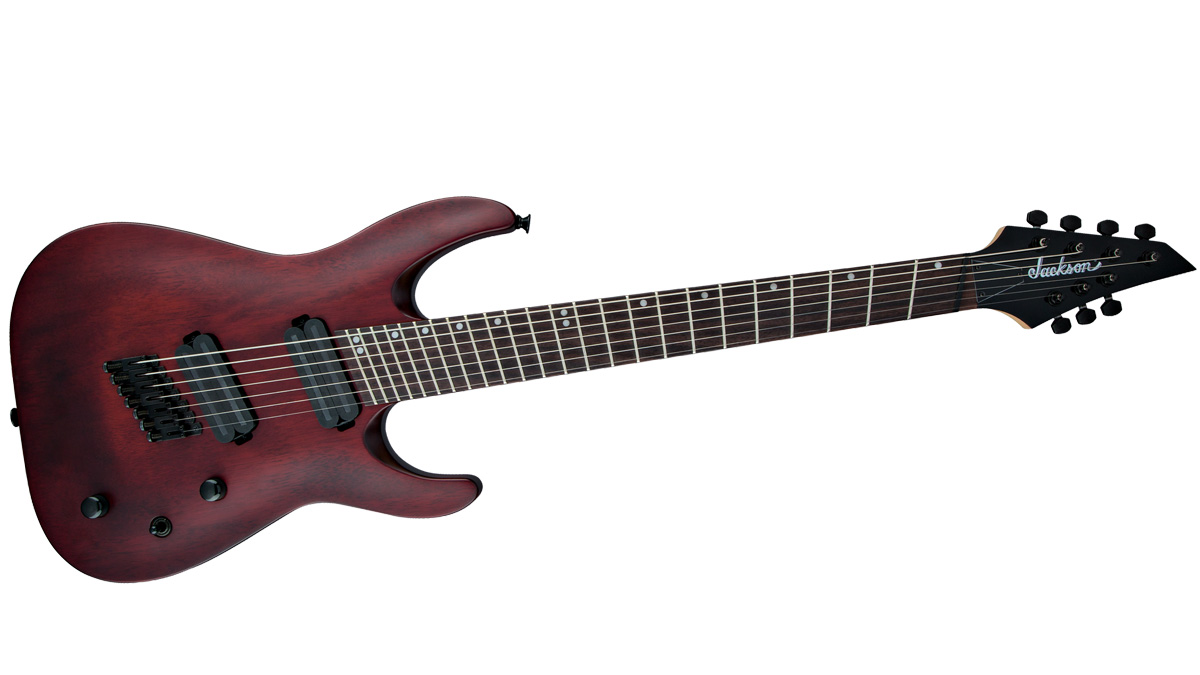MusicRadar Verdict
At this price point, Jackson has pulled off an impressive feat. If you can deal with the heel access and the pickups, this is a worthy entry to fan-fret-dom.
Pros
- +
Great value for money, especially for a fan-fret.
Cons
- -
Lack of an all-access heel seems a missed opportunity. Players may well want to upgrade the pickups down the line.
MusicRadar's got your back
Before you make a frenzied call to your optometrist, we should point out that this latest seven-string from Jackson’s value-for-money X Series is a multi-scale (or fan-fret) guitar, which is something that, until now, you’d have struggled to find in this price range.
A multi-scale design has a longer scale length for lower strings and a shorter one for higher strings, making for improved tuning and intonation. This gives the low B the potential to further vibrate and promises to be more comfortable to play too.
On to the matter at hand, the DKAF7 MS takes the extended-range Jackson Dinky format and pushes it to its tech-metal limits (an eight-string incarnation is also available). Besides the 647mm-685mm (25.5-27") scale length, the rosewood fingerboard also boasts a 305mm-406mm (12-16") compound radius, so it’s rounder at lower frets for chords and flatter for easy bends up top.
Close your eyes, and you’re unlikely to notice you’re even playing a fan-fret model, aside from a more fluid feel. If you think about the way your fretting hand moves while playing, it’s not hard to see how fan-fretting can make movements more natural - handy for sweeping and legato. Sure, it isn’t going to turn you into Plini overnight, but it does help to make your moves that bit slicker.
Close your eyes, and you’re unlikely to notice you’re even playing a fan-fret model, aside from a more fluid feel
With a sleek satin finish, the neck is a joy to play, at least until you get up to the dusty end - the bolt-on heel, although contoured, is a little larger than shredders might expect, and not dissimilar to the usual Strat assembly. Given the market this guitar is aimed at, it seems an oversight on an otherwise eminently playable, forward-thinking instrument.
Pickups are usually where a more affordable guitar reveals itself, and that’s true of the Jackson, to an extent. While they look the business, the own-brand blade ’buckers are a mixed bag.
The neck is a little dark for most tastes - it works for flutey leads, but not so much for chunky overdriven chord playing. Thankfully, the middle position brightens things up enough for clean sounds.
Faring better is the bridge humbucker, which offers a punchy, full-throated output that cuts through distortion with aplomb although, again, the clean sound leaves a little to be desired. It’s a more classic voice than the hi-fi sounds many extended-range players prefer, so if cleans are important to you, bear the cost of a pickup upgrade in mind.
Mike is Editor-in-Chief of GuitarWorld.com, in addition to being an offset fiend and recovering pedal addict. He has a master's degree in journalism, and has spent the past decade writing and editing for guitar publications including MusicRadar, Total Guitar and Guitarist, as well as a decade-and-a-half performing in bands of variable genre (and quality). In his free time, you'll find him making progressive instrumental rock under the nom de plume Maebe.
“I’m beyond excited to introduce the next evolution of the MT15”: PRS announces refresh of tube amp lineup with the all-new Archon Classic and a high-gain power-up for the Mark Tremonti lunchbox head
"You can repurchase if it works for your schedule": Fyre 2, Billy McFarland’s ‘luxury’ festival is postponed indefinitely
“I actually specifically remember making a deal with myself": Billie Eilish reveals what she had to do in order to become “looser and jazzier” with her vocal delivery











